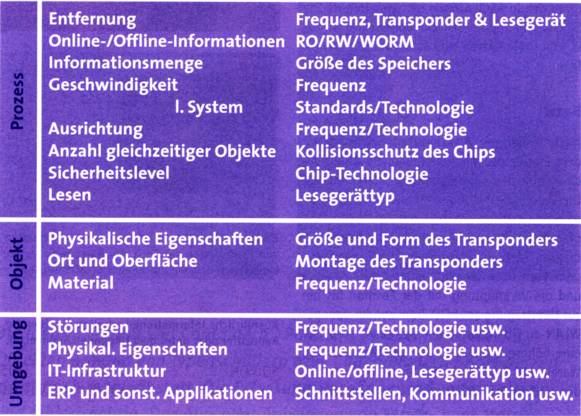What you should consider when introducing RFID technology
Dr. Bernd Reineke is Managing Director of Abels & Kemmner GmbH, Herzogenrath/Aachen
Many companies are asking themselves whether the time has finally come to introduce RFID technology with the availability of the new Generation 2 tags or whether they should wait and see. Before investing in the new technology, the questions of suitability and reliability, additional benefits and profitability should always be asked. Poorly prepared restructuring often leads to a cost trap, frustration and subsequent abandonment.
With every new technology, early adoption is fraught with risks on the one hand, but on the other hand there are always opportunities to achieve enormous competitive advantages. This also applies to the “hot topic” of RFID. RFID technology actually offers everything that logisticians dream of: contactless reading of information without visual contact, decentralized updating of information directly on the product, automatic stocktaking at the touch of a button, automation of logistical procedures and manufacturing processes, huge savings potential, recognition of stock-out situations, and much more. All in all, this opens up huge savings potential and enormous potential for business process optimization. And all this is now even more secure and flexible thanks to Generation 2 tags with additional frequency bands, faster transfer rates and less susceptibility to interference. However, as with any investment in a new technology, the use of RFID raises questions about suitability and reliability, additional benefits and profitability. So before introducing RFID and declaring it a strategic business component, it is advisable to examine these questions in detail and, if necessary, test them in small pilot areas. Of course, there are successful RFID applications that can be used as benchmarks.
On closer inspection, however, they are often not transferable one-to-one to corporate logistics: Car immobilizers, access control (e.g. at ski lifts), animal identification, toll control – with all these solutions, humans can intervene manually in the event of problems (e.g. access control), or errors within a certain tolerance are accepted (e.g. toll control). But what if a reading accuracy of 96% is achieved in the logistics process during bulk detection (detection of many tags in one reading process)? If booking processes, e.g. in the ERP system, are linked to the reading processes, stock differences occur within a short period of time, leading to considerable disruptions in the logistics process. Without careful examination, you quickly run the risk of generating damage from planned benefits.

Check applicability carefully
So before you invest in the new technology, you need to check its applicability very carefully. The following procedure is recommended:
- Definition of the RFID application area: Identification of the processes, the affected products, the application environment with regard to the optimization potential and implementation possibilities to be maintained. There is potential for optimization particularly in the automation of manual activities, the recording of mass data, error prevention and traceability down to the individual product.
- Definition of the technical specifications: With the help of RFID experts, the right standards and hardware must be selected, taking into account environmental conditions, materials, quantity structure, connection to the company IT, tag cycles, etc. (see image). A decision must be made as to whether closed tag loops (i.e. reuse of the RFID tags) or open loops with loss of the tags should be selected. The latter can have a considerable influence on the achievable ROI.
- Carry out a feasibility study: Beforehand, the possible applications of the selected RFID technology must be tested using pilot installations in a specific environment. In addition to the reading quality, compliance with the prescribed limit values for the effect on humans should also be checked here. The equipment required for these tests can be provided by the consultant or appropriate institutes. Only when the facts are on the table and feasibility has been proven can a decision be made on how to proceed.
- Profitability analysis: After estimating the potential savings to be expected through optimized processes, error prevention, traceability, etc., the investments to be made must be compared and evaluated. If cross-company processes are affected by the use of RFID, possible savings with the business partner must also be taken into account. However, the prerequisite for this is that the business partner contributes to the costs or rewards the added value accordingly.
- Preparation and application in a pilot area: In a small, manageable area, the processes are to be optimized and adapted with the use of RFID. This enables experience to be gathered at low cost and creates confidence for the subsequent rollout phase.
- Rollout to other areas/products
Tests in pilot areas are recommended before RFID is introduced
As holistic an approach as possible
However, a structured approach alone is no guarantee of a successful technology launch. External support is highly recommended, especially if you are dealing with RFID technology for the first time, despite its standardization, and the associated logistics and IT adjustments that are usually required. Bad investments can thus be avoided. And the project is usually completed in less time at a lower overall cost. In addition to the necessary technical know-how, particular attention should be paid to experience in the optimization of internal and cross-company business processes when selecting experts. Ultimately, the main potential of the new technology lies in business process optimization, which should be approached as holistically as possible, i.e. with the involvement of suppliers and customers if necessary.
Focus on efficiency
In addition, the introduction and implementation competence is also a decisive criterion. Choosing the right service provider is not easy, because you won’t find providers of this type like sand by the sea. Smaller, but highly specialized application consultants are ideal, as they can call on system houses and institutes in the competence network flexibly and on a case-specific basis, making it possible to compare and try out products from different hardware and software manufacturers. Abels & Kemmner is one such provider with more than 10 years of expertise in the use of barcodes and, more recently, RFIDs in internal and cross-company supply chain management. The focus is always on efficiency, which is usually achieved by synchronizing production with the market and thus increasing delivery readiness while reducing inventories at the same time. If this is possible – and according to all known studies this is the case for most companies – the introduction of automatic recognition systems such as RFID pays for itself within a very short time.
About Abels & Kemmner
Abels & Kemmner GmbH was founded in 1993 by the engineers and economists Dr. Helmut Abels and Dr. Götz-Andreas Kemmner. One focus of the company is the streamlining of value chains (supply chain optimization) for series and variant manufacturers as well as wholesalers. Abels & Kemmner deals with the design and optimization of order processing and logistics from suppliers to customers and from article assortment to IT support. Supply chain concepts developed with customers have already won two best practice awards. A&K caused a sensation in 1997 with the founding of the first virtual company made up of six medium-sized companies in the automotive supply industry. The second focus is on restructuring and earnings enhancement projects. Here, the consultants develop going concern forecasts as well as restructuring and downsizing concepts and implement these in the companies. They have made a name for themselves in crisis and turnaround management through the successful restructuring of medium-sized companies. In recent years, Abels & Kemmner has been involved in the restructuring of the majority of major corporate insolvencies in Saarland.

